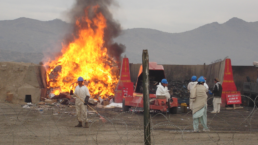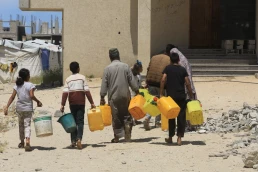Afghans who lived near America’s vast bases say the U.S. military’s lack of even minimal environmental protections polluted their land, poisoned their water and sickened their children. The consequences of the contamination may last for generations.
By Lynzy Billing, Inside Climate News
This investigation was co-produced with New Lines Magazine and supported in part by a grant from The Fund for Investigative Journalism.
Birds dip between low branches that hang over glittering brooks along the drive from Jalalabad heading south toward the Achin district of Afghanistan’s Nangarhar province. Then, the landscape changes, as lush fields give way to barren land.

Up ahead, Achin is located among a rise of rocky mountains that line the border with Pakistan, a region pounded by American bombs since the beginning of the war.
Laborers line the roadside, dusted with the white talc they have carried down from the mountains. A gritty wind stings their chapped cheeks as they load the heavy trucks beside them. In these parts of Achin, nothing else moves in the bleached landscape. For years, locals say this harsh terrain has been haunted by a deadly, hidden hazard: chemical contamination.
In April 2017, the U.S. military dropped the most powerful conventional bomb ever used in combat here: the GBU-43/B Massive Ordnance Air Blast, known unofficially as the “mother of all bombs,” or MOAB.
Before the airstrike, Qudrat Wali and other residents of Asad Khel followed as Afghan soldiers and U.S. special forces were evacuated from the area. Eight months after the massive explosion, they were finally allowed to return to their homes. Soon after, Wali says, many of the residents began to notice strange ailments and skin rashes.
Recent Posts
“Arrest Now, Ask Questions Later”: Why Did L.A. ICE Agents Arrest and Jail U.S. Citizen Andrea Velez?
July 3, 2025
Take Action Now “They didn’t have vests that said ICE or anything. Their cars didn’t have license plates. … Just because of the color of our…
Trump’s Big, Beautiful Bill Is Naked Class War
July 3, 2025
Take Action Now Trump’s “Big, Beautiful Bill” trades tax cuts on millionaires for the dissolution of society.By Hamilton Nolan, In These Times…
Mayor Mamdani’s First Day, A Zero Hour Conversation With Richard Wolff
July 2, 2025
Take Action Now If elected, what would Mayor Mamdani do on his first day in City Hall? How would a democratic socialist govern as a big-city mayor?……
The U.S. Is Funding A Bloodbath At Gaza Aid Centers
July 2, 2025
Take Action Now The admin just gave $30M to GHF, the organization at the center of charges that Israel is weaponizing assistance and shooting at…




